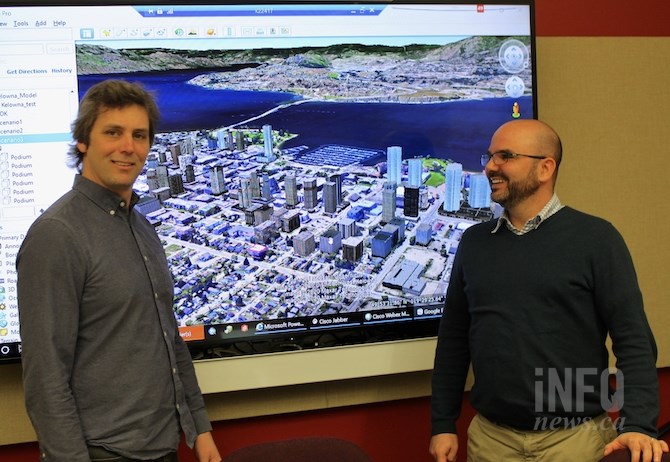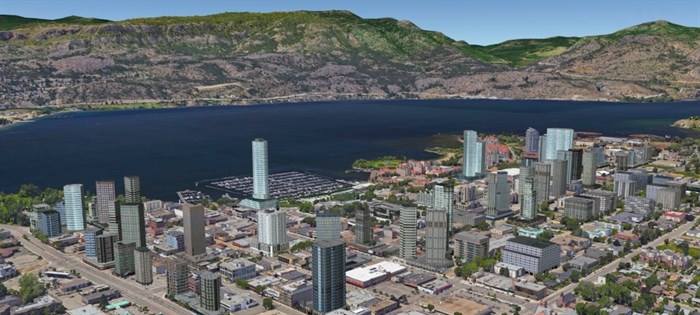
Graham March (left) and Kevin Stehle are two of the creators of Kelowna's ModelCity Future.
(ROB MUNRO / iNFOnews.ca)
March 09, 2020 - 6:00 AM
Creativity doesn’t work in a vacuum
The creation of Kelowna’s ModelCity Future is not only an example of just how creative public sector workers can be but also shows how the culture is changing at City Hall. ModelCity is a visually stunning computer model of the city but using intensive amounts of data to allow city officials to see future development and growth and their impacts on the city from tax dollars to required public amenities and so much more.
What it does and what it means for Kelowna City Hall is actually exciting — not a word often associated with municipal government.
“We do want to become a progressive city,” planning specialist Graham March said.
“I know our mission statement’s changing. I know that sounds corny but it really is. We want to become the best mid-sized city. That gives us some latitude to come up with some really interesting concepts.”
This is not coming from some senior manager coached to stick to corporate talking points but from a rank-and-file worker. He's a union member who actually bargained the last collective agreement, and who has high praise for his bosses – including city manager Doug Gilchrist – who have embraced the idea of making decisions highly influenced by data.
The process to create ModelCity Future began five years ago when March and a couple of colleagues were assigned to start working on the city’s new Official Community Plan. That led to the creation of technology that only a couple of major American cities come close to matching.
“The challenge was, how do we proactively plan for the future based on something other than intuition?” March said. “So we thought, how do we include data to make better guesses about where growth might occur? We’re maximizers in the sense that we like to take a project and make it better. That’s a trait that we all have.”
It not only helped that senior management encouraged them to be innovative but that new hires helped bring skilled people into the mix, creating a “perfect storm” of creativity, collaboration and a cultural shift at City Hall.
Other cities, at this point in time, are creating 3D models of how their cities might grow. The huge amount of data incorporated into Kelowna's ModelCity program can overlay a rendering of future high rises downtown with things like parks, bike lanes and sewer lines.
March started the assignment with Cameron Noonan, a transportation planner and Kevin Wang from Information Services as they worked to show how different growth options would affect the city.
Noonan, for example, was able to incorporate data from Stats Canada to estimate how many people might live in a particular tower, taking into consideration unit sizes, the average population per condo unit versus a single-family home and the fact that a certain number of units would likely be vacant.

This is what downtown Kelowna could look like with 5,000 more residents.
Image Credit: Submitted/City of Kelowna
At about the same time, Kevin Stehle was one of those new employees who was hired as the city’s first business systems analyst. His job was to look at what facilities the city will need in the future with suggestions on where they should be located.
“I was a new employee at the time and didn’t know anyone,” he noted.
It didn’t take long for him to connect with the others since they were doing similar work and his new department, which has now grown to two members, are known as “silo busters,” meaning they’re mandated to break down barriers between departments.
They pointed out that, on its own, each database does not have a great deal of value but, by inputting the ton of data the city has into one system, that allows them to create complete pictures of what can happen in the city if, for example, a new high rise proposal comes to the city.
Not only does the model provide invaluable tools to city council and, eventually the public when it becomes more accessible on the city’s web site, it also shows the value of having an interdepartmental team.
Stehle, for example, was assigned to work on ModelCity in 2017 but was called away because of flooding in the city.
“Working in the city, you never know what’s going to pop up,” he said. “ModelCity Future was supposed to be my whole year and I spent eight months of that year doing flood model predictions and deciding where sandbags went in.”
As a result, Noonan – who Graham calls a genius — built the model.
This is just the beginning of what can be done as their resources and database build.
And they don’t know all it can do right now.
“Sometimes you don’t understand until someone asks the question,” March said.
There may, for example, be an opportunity to sell, adapt and maintain the system for other cities.
While they’ve had some discussions about such ventures, it may take the addition of a marketing specialist to show, for example, how marketing it might pay for the cost of hiring more staff to expand the system.
To contact a reporter for this story, email Rob Munro or call 250-808-0143 or email the editor. You can also submit photos, videos or news tips to the newsroom and be entered to win a monthly prize draw.
We welcome your comments and opinions on our stories but play nice. We won't censor or delete comments unless they contain off-topic statements or links, unnecessary vulgarity, false facts, spam or obviously fake profiles. If you have any concerns about what you see in comments, email the editor in the link above.
News from © iNFOnews, 2020